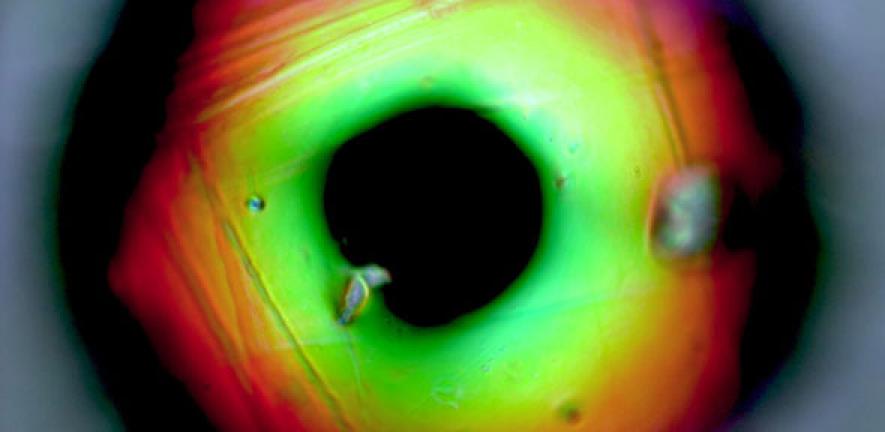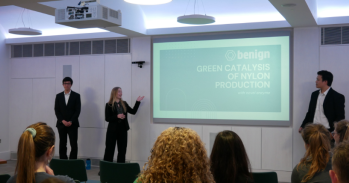
The development of a ‘nanobarrel’ that traps and concentrates light onto single molecules could be used as a low-cost and reliable diagnostic test.
The development of a ‘nanobarrel’ that traps and concentrates light onto single molecules could be used as a low-cost and reliable diagnostic test.
Eventually... we will be able to build things with light itself
Jeremy Baumberg
Jeremy Baumberg and his 30-strong team of researchers are master manipulators of light. They are specialists in nanophotonics – the control of how light interacts with tiny chunks of matter, at scales as small as a billionth of a metre. It’s a field of physics that 20 years ago was unknown.
At the heart of nanophotonics is the idea that changing the structure of materials at the scale of a few atoms can be used to alter not only the way light interacts with the material, but also its functional properties.
“The goal is to design materials with really intricate architecture on a really small scale, so small it’s smaller than the wavelength of light,” said Baumberg, Professor of Nanophotonics in the Department of Physics. “Whether the starting material is polystyrene or gold, changing the shape of its nanostructure can give us extraordinary control over how light energy is absorbed by the electrons locked inside. We’re learning how to use this to develop new functionality.”
One of their recent achievements is to develop synthetic materials that mimic some of nature’s most striking colours, among them the iridescent hue of opals. Naturally occurring opals are formed
‘Polymer opals’, however, are plastic – like the polystyrene in drinking cups – and formed within a matter of minutes. With some clever chemistry, the researchers have found a way of making polysterene spheres coated in a soft chewing-gum-like outer shell.
As these polymer opals are twisted and stretched, ‘metallic’ blue–green colours ripple across their surface. Their flexibility and the permanence of their intense colour make them ideal materials for security cards and banknotes or to replace toxic dyes in the textile industry.
“The crucial thing is that by assembling things in the right way you get the function you want,” said Baumberg, who developed the polymer opals with collaborators in Germany (at the DKI, now the Fraunhofer Institute for Structural Durability and System Reliability). “If the spheres are random, the material looks white or colourless, but if stacked perfectly regularly you get colour. We’ve found that smearing the spheres against each other magically makes them fall into regular lines and, because of the chewing gum layer, when you stretch it the colour changes too.
“It’s such a good example of nanotechnology – we take a transparent material, we cut it up in the right form, we stack it in the right way and we get completely new function.”
Although nanophotonics is a comparatively new area of materials research, Baumberg believes that within two decades we will start to see nanophotonic materials in anything from smart textiles to buildings and food colouring to solar cells.
Now, one of the team’s latest discoveries looks set to open up applications in medical diagnostics.
“We’re starting to learn how we can make materials that respond optically to the presence of individual molecules in biological fluids,” he explained. “There’s a large demand for this. GPs would like to be able to test the patient while they wait, rather than sending samples away for clinical testing. And cheap and reliable tests would benefit developing countries that lack expensive diagnostic equipment.”
A commonly used technique in medical diagnostics is Raman spectroscopy, which detects the presence of a molecule by its ‘optical signature’. It measures how light is changed when it bounces off a molecule, which in turn depends on the bonds within the molecule. However, the machines need to be very powerful to detect what can be quite weak effects.
Baumberg has been working with Dr Oren Scherman, Director of the Melville Laboratory for Polymer Synthesis in the Department of Chemistry, on a completely new way to sense molecules they have developed using a barrel-shaped molecular container called cucurbituril (CB). Acting like a tiny test tube, CB enables single molecules to enter its barrel shape, effectively isolating them from a mixture of molecules.
In collaboration with researchers in Spain and France, and with funding from the European Union, Baumberg and Scherman have found a way to detect what’s in each barrel using light, by combining the barrels with particles of gold only a few thousand atoms across.
“Shining light onto this gold–barrel mixture focuses and enhances the light waves into tiny volumes of space exactly where the molecules are located,” Baumberg explained. “By looking at the colours of the scattered light, we can work out which molecules are present and what they are doing, and with very high sensitivity.”
Whereas most sensing equipment requires precise conditions that can only really be achieved in the laboratory, this new technology has the potential to be a low-cost, reliable and rapid sensor for mass markets. The amount of gold required for the test is extremely small, and the gold particles self-assemble with CB at room temperature.
Now, with funding from the Engineering and Physical Sciences Research Council, and working with companies and potential end users (including the NHS), Baumberg and Scherman have begun the process of developing their ‘plasmonic sensors’ to test biological fluids such as urine and tears, for uses such as detecting neurotransmitters in the brain and protein incompatibilities between mother and fetus.
“At the same time, we want to understand how we can go further with the technology, from controlling chemical reactions happening inside the barrel, to making captured molecules inside ‘flex’ themselves, and detecting each of these modifications through colour change,” added Baumberg.
“The ability to look at small numbers of molecules in a sea of others has appealed to scientists for years. Soon we will be able to do this on an unprecedented scale: watching in real time how molecules come together and undergo chemical reactions, and even how they form a bond. This has huge implications for optimising catalysis in industrially relevant processes and is therefore at the heart of almost every product in our lives.”
Baumberg views nanophotonics technology as a whole new toolbox. “The excitement for me is the challenge of how difficult the task is combined with the fact that you can see that, if only you could do it, you can get things out that are incredible.
“At the moment we are capable of assembling new structures with different optical properties in a highly controlled way. Eventually, though, we will be able to build things with light itself.”
The text in this work is licensed under a Creative Commons Licence. If you use this content on your site please link back to this page. For image rights, please see the credits associated with each individual image.





